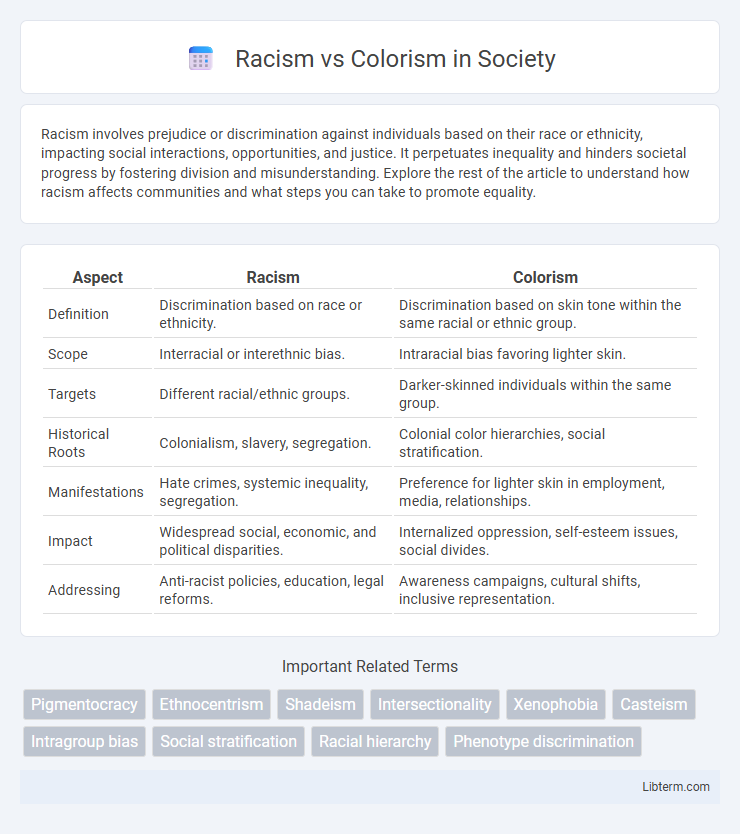Racism involves prejudice or discrimination against individuals based on their race or ethnicity, impacting social interactions, opportunities, and justice. It perpetuates inequality and hinders societal progress by fostering division and misunderstanding. Explore the rest of the article to understand how racism affects communities and what steps you can take to promote equality.
Table of Comparison
| Aspect | Racism | Colorism |
|---|---|---|
| Definition | Discrimination based on race or ethnicity. | Discrimination based on skin tone within the same racial or ethnic group. |
| Scope | Interracial or interethnic bias. | Intraracial bias favoring lighter skin. |
| Targets | Different racial/ethnic groups. | Darker-skinned individuals within the same group. |
| Historical Roots | Colonialism, slavery, segregation. | Colonial color hierarchies, social stratification. |
| Manifestations | Hate crimes, systemic inequality, segregation. | Preference for lighter skin in employment, media, relationships. |
| Impact | Widespread social, economic, and political disparities. | Internalized oppression, self-esteem issues, social divides. |
| Addressing | Anti-racist policies, education, legal reforms. | Awareness campaigns, cultural shifts, inclusive representation. |
Understanding Racism: A Broad Overview
Racism involves systemic discrimination and prejudice based on race, deeply rooted in historical, social, and institutional structures that oppress marginalized racial groups. It manifests through unequal access to resources, opportunities, and justice, reinforcing power imbalances on a societal scale. Understanding racism requires analyzing both overt actions and embedded biases that perpetuate racial hierarchies and inequalities globally.
Defining Colorism: Bias Within Communities
Colorism refers to the preferential treatment and discrimination based on skin tone within the same racial or ethnic group, often favoring lighter skin over darker shades. This bias influences social dynamics, economic opportunities, and self-esteem, perpetuating inequality internally. Understanding colorism is crucial for addressing nuanced forms of prejudice that coexist alongside broader racism.
Historical Roots of Racism and Colorism
Racism and colorism both stem from historical systems of oppression rooted in colonialism and slavery, which enforced racial hierarchies privileging whiteness. Racism broadly targets entire racial groups, often institutionalized through laws and social norms, while colorism discriminates within racial groups based on skin tone, favoring lighter complexions linked to colonial ideals of beauty and power. These legacies perpetuate social inequalities, shaping contemporary experiences of discrimination and identity across various cultures worldwide.
Key Differences Between Racism and Colorism
Racism involves discrimination based on race or ethnic group, targeting entire racial categories often resulting in systemic inequality and social exclusion. Colorism, however, refers to prejudice within a racial or ethnic group that favors individuals with lighter skin tones, affecting social status and opportunities. Key differences include the scope--racism operates between different races while colorism functions within a race--and the basis of bias focusing on skin shade rather than broader racial identity.
Intersections: How Racism and Colorism Interact
Racism and colorism intersect by reinforcing hierarchical structures that privilege lighter skin within and across racial groups, intensifying social inequalities. This interaction perpetuates systemic discrimination, where individuals with darker skin tones face compounded biases in employment, education, and media representation. The overlapping effects of racism and colorism create complex challenges in achieving racial equity and social justice.
Global Perspectives on Racism and Colorism
Racism, rooted in systemic discrimination based on race, varies globally with distinct historical and cultural consequences in regions like the Americas, Europe, and Africa. Colorism, a form of prejudice favoring lighter skin shades within racial or ethnic groups, manifests uniquely in countries such as India, Brazil, and the Philippines, influencing social hierarchy and opportunities. Both racism and colorism intersect worldwide, affecting policy, identity, and social dynamics across diverse populations.
Real-World Examples and Case Studies
Racism manifests in systemic discrimination such as apartheid in South Africa and Jim Crow laws in the United States, targeting people based on race or ethnicity. Colorism, a form of intra-racial bias, is evident in the preferential treatment of lighter skin tones within communities, as seen in the entertainment industries of India and the Philippines. Case studies like the 2016 Nivea advertisement controversy highlight how colorism perpetuates harmful stereotypes, while the Black Lives Matter movement addresses broader racial injustices globally.
The Impact of Racism vs. Colorism in Society
Racism and colorism both perpetuate social inequality but differ in scope and impact, with racism targeting entire racial groups and colorism focusing on skin tone within those groups. Racism enforces systemic discrimination through policies and social practices that marginalize people of certain races, leading to disparities in education, employment, and justice. Colorism, often internalized within communities of color, causes division and unequal treatment based on lighter or darker skin tones, intensifying social stratification and psychological harm.
Combating Racism and Colorism: Strategies for Change
Combating racism and colorism requires implementing comprehensive education programs that promote awareness of systemic inequalities and encourage empathy across diverse communities. Policies fostering equitable representation and anti-discrimination laws must be enforced rigorously to dismantle structural biases. Community-driven initiatives that amplify marginalized voices play a crucial role in advancing social justice and cultural inclusivity.
Moving Forward: Towards Inclusivity and Equity
Moving forward towards inclusivity and equity requires addressing both racism and colorism through systemic reforms in education, employment, and media representation. Emphasizing policies that promote diversity, equitable resource allocation, and anti-discrimination training fosters environments where all individuals are valued regardless of race or skin tone. Collaborations between community leaders, policymakers, and activists enhance social awareness and drive sustainable change toward a more just society.
Racism Infographic

 libterm.com
libterm.com